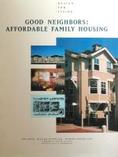urbanism conservation & preservation sociology history safety & security local development giornata di studi inu waterfronts & harbors representation city creativity urban form ricerca climate change spatial planning Environment job technology competition composition heritage conferences citizenship social practices urban design
Good neighbors: affordable family housing - Review
by Lorenzo Venturini
It is ordinary America the one that Tom Jones, William Pettus and Mike Pyatok describe in their book on U.S. housing and community planning. Good Neighbors: Affordable family housing - this is the title of this challenging book - speaks about another America, the one that hardly ever finds a place in newspapers and magazines because usually it is overwhelmed by the most common archetypical images. Sparkling are such images when they express financial and technological power; carefree when they convey the idea of open space and free time seaside or mountain escape; dramatically violent and deteriorated when they express social and legal problems.
Through the description of their vision of life styles, Jones, Pettus and Pyatok offer us a sample of North American social living styles, of the variety of regional architectural expressions, of the difference among urban centers, suburbs, countryside and their relationship with public space and historical identity.
Written in a simple linear style, the book tells us about a new interpretation of the designer's profession that derives from the authors' clear social and civic convictions in their job considered as a community service.
Through the illustration of the housing problems a great number of Americans has to face, of the welfare system and of the applied experiences, the authors portray American social life. They also describe the neighborhood life and the citizens efforts to overcome economical, ethnic, and cultural barriers.
In the wide review of study cases collected in this book, exceptional architectures are rarely found, if we take the word "exceptional" as contemporary architectural style. The majority of the projects is inspired to tradition in the constant search for a urban model that encourages identification and socialization. On the contrary, "exceptional" is the design process care, the constant search for a better human living dimension considered as everybody's right even though the customers are low income people and budgets are limited.
A thorough quest of the aspects that improve everyday life is evident in the book together with the search for social aggregation and a sense of belonging to a community. Moreover, the community planning method and the theoretical aspects are verified during the design process with the neighbors and the new inhabitants. The book is rich in descriptions of the social, economic and legislative context in which affordable housing designers work. All the aspects regarding the community design are confronted: the subjects living in community housing, the needs expressed by them, the factors influencing the community housing design. The second half of the text concentrates on a rich variety of study cases accompanied by photos and essential information.
The authors gained a long experience in the community housing field: Tom Jones was Director of Architecture of the Asian Neighborhood Design of San Francisco, a company that works for the development of the non-profit settlements. He worked in the community planning field and he has a 25-year experience in public housing. Working for the AND Company he won several prizes for community planning and for his dedication in design. William Pettus worked as an architect in affordable housing and community planning design. He taught design at the University of California at Berkeley and edited several books on San Francisco Bay Area community planning. Michael Pyatok designed lots of family housing throughout the US. Winner of several design prizes and competitions, he collaborated with communities in the design process. At the moment he teaches at the University of Washington School of Architecture in Seattle.
This is a review for:
[Book] Good neighbors: affordable family housing
by Tom Jones, William Pettus, Mike Pyatok




Planum
The Journal of Urbanism
ISSN 1723-0993
owned by
Istituto Nazionale di Urbanistica
published by
Planum Association
ISSN 1723-0993 | Registered at Court of Rome 4/12/2001, num. 514/2001
Web site realized by ChannelWeb & Planum Association | Powered by BEdita 3

